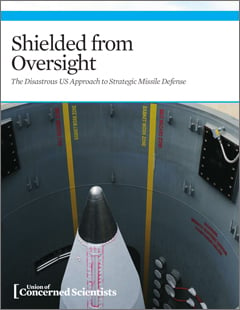Decades of research and development. Forty billion in taxpayer dollars. Test flights that fail more often than not.
It’s not the beginning that George W. Bush envisioned for US missile defense when he ordered the system built in 2002. And yet it’s the reality of national missile defense today—an expensive false promise that was rushed to the field without oversight or accountability.
How did we get here—and what does it mean for US security? Analysis by the Union of Concerned Scientists found fundamental flaws throughout the missile defense program, from its administration and oversight procedures to the tough technical realities of defending against a nuclear strike. Congress and the administration owe it to national security—and US taxpayers—to critically reevaluate the system’s purpose, costs, and benefits.
Defending the United States from nuclear-tipped missiles is not a new idea. In the 1950’s and 60’s, both the United States and Soviet Union experimented with “defensive” nuclear missiles, meant to intercept and destroy incoming warheads.
What’s next?
Despite years of evidence to the contrary, US officials still make broad and misleading claims about the GMD system’s effectiveness. Congress has urged adding a new East Coast missile defense site several times, and has proposed legislation that would greatly expand the role and mandate of the current system.
But in its current form, strategic missile defense is a waste of resources at best and dangerous at worst. It is not a reliable defense under real-world conditions; by promoting it as a solution to nuclear conflict, US officials complicate diplomatic efforts abroad, and perpetuate a false sense of security that could harm the US public.
Missile defense basics
The premise behind national missile defense is simple: when a hostile launch is detected, destroy the incoming missiles by ramming them with ground-launched “interceptors” (a strategy known as “hitting a bullet with a bullet”). In reality, the system is easy to defeat, and has routinely failed even simple, heavily-scripted test intercepts.
Those early efforts were mostly abandoned with the signing of the Anti-Ballistic Missile (ABM) Treaty in 1972, as both nations recognized the risk of an out-of-control arms race (one “solution” for overcoming missile defense is to simply overwhelm it).
And yet, national missile defense—the idea of knocking intercontinental ballistic missiles (ICBMs) out of the sky—kept popping up. President Ronald Reagan included it in his vision for making nuclear weapons “impotent and obsolete”; the Clinton administration focused on simple threats from emerging states; and in 2002, George W. Bush officially withdrew from the ABM treaty and ordered the rapid, immediate fielding of a national missile defense system (officially termed “Ground-based Midcourse Defense,” or GMD).
Ineffective and expensive
Under Presidents Bush and Obama, the newly-christened US Missile Defense Agency established two missile defense sites—one in Fort Greely, Alaska, the other at California’s Vandenberg Air Force base. The implied goal was, and continues to be, to defend the United States against a nuclear attack from an emerging or rogue state, such as North Korea or Iran.
The system faced fundamental technical issues from the very beginning. Early analysis by the Union of Concerned Scientists showed how countermeasures (such as decoy warheads) could defeat US missile defense—and that such countermeasures would be available to any country developing intercontinental ballistic missiles.
The United States didn’t listen. In the 15 years since Bush’s order, the GMD system consistently failed intercept tests—six out of nine—despite heavily-scripted test conditions that don’t mirror real-world conditions. Countermeasures were never addressed, and administration officials never offered a credible technical approach or vision on how to do so.
To date, the system has cost more than $40 billion—and there’s no end in sight.
Missile defense quick facts
- The GMD system has cost $40 billion
- Between 2002 and 2016, six out of nine test intercepts failed. See an updated list of test results here.
- No credible plan for defeating countermeasures
Who’s accountable?
From the first days of its deployment, the GMD system suffered from a disturbing lack of accountability. Rather than using the standard, time-tested “fly-before-you-buy” approach to developing military systems, the Bush administration fast-tracked missile defense, exempting it from many of the mandatory oversight, accountability, and financial transparency procedures used by Congress and the military for decades.
President Obama’s administration did little to change course.
The result? Expensive purchases of unproven technologies, major schedule and cost overruns, an abysmal test record, and, nearly fifteen years later, no proven capability to protect the United States—and no credible path forward for achieving success.




